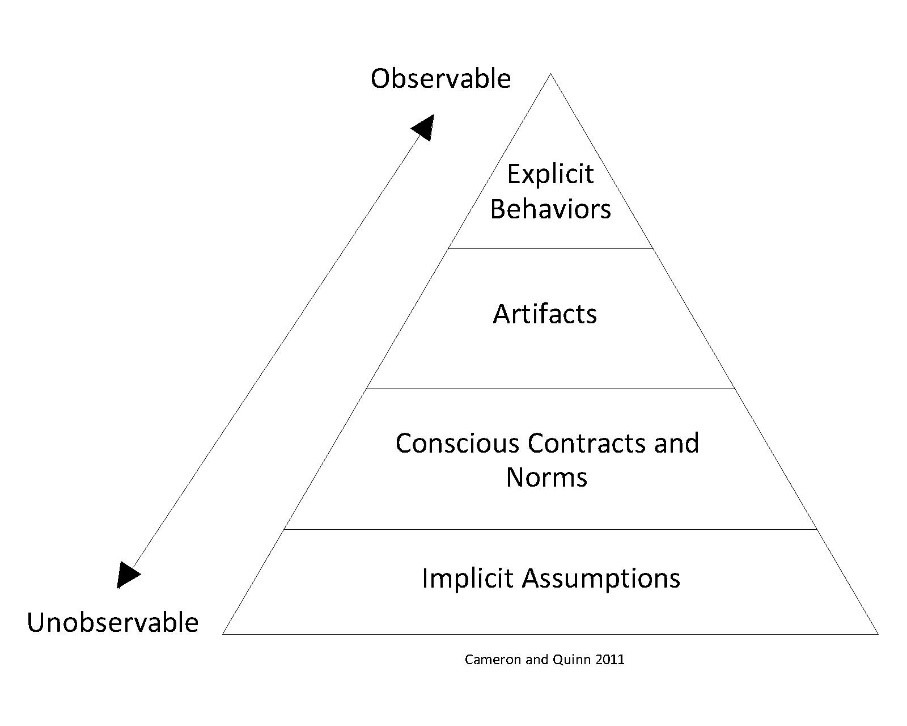How often do you experience stress pain in your back? Kavita Trivedi, DO, who specializes in physical medicine and rehabilitation, notes “When you’re stressed, your breathing patterns change and cause strain and tension in the mid-back. Your shoulders hunch up and cause pain throughout the upper and middle back.”[i] I agree. I get my pain in between my shoulder blades – surely because my shoulders are saying hello to my ears. When I feel it for several days, I know it’s time to pay attention to what’s creating this tension, this posture in my body. Focus. Is there something in my workplace culture that needs tending or something within me or both? Time to strengthen my back.
I think a lot about healthy workplace cultures. I read a lot about it too. A book I highly recommend is Diagnosing and Changing Organizational Culture by Kim S. Cameron and Robert E. Quinn. Riveting information. This book explains the Elements of Organizational Culture[ii] captured well in the diagram below.

I like that they display it as a pyramid because that’s how a culture in any organization is built – from the ground up. It’s a fantastic visualization of reality.
When we see an organizational chart, it flows from the top down. The CEO at the top. However, when a business, company, firm, any organization is built, it’s built from the ground up, including its culture. It follows then that the founding leader(s) of the organization is where it all begins. It’s their Implicit Assumptions – whose ‘back’, aka the base, the company is built upon. That’s a lot of responsibility; potentially a lot of stress. When leadership changes – so does the back.
Within an organization – each unit, team, section, etc., is greatly influenced by the larger organizational culture, but they all have their own nuances because of the leader(s) in that sub-system. People in the organization know whose team they want to be on, what area of the plant is the best to work in… because the culture creator, the leader, built a pocket of excellence in that sub-system. Is the sub-system influenced by the overall culture? Yes, of course. However, what to align with; what to comply with; and what to reframe is the sub-system leader’s decision – his/her back.
Regarding the Implicit Assumptions – they are vast. It’s not about a desire to build an empire, or to make a decent living, or to sell a product. Implicit Assumptions are personal. It’s about the actual person – beliefs, values, knowledge, behaviors, interpersonal capabilities, and psyche of the leader that creates the culture. It’s the person after all that is the leader. It’s true they have position power, but it’s the personal power that creates the culture.
Let me give you an example. If the leader came from a rigid home environment, he may behave in a micromanaging manner. Do you feel respected being micromanaged? If the leader came with a belief from another company that high anxiety leads to high productivity, she may think creating an anxious environment will increase productivity. Have you ever felt safe or creative being anxious? I can feel the twinge in my back starting just thinking about that.
In a healthy culture – people feel safe, understood, nurtured, respected, creative, innovative, clear, happy, ready to listen, contribute, and work. In a healthy culture – it’s easy to have trusting, respectful, reliable, supportive, empathic relationships. In a healthy culture – individuals, clients, and the organization prosper.
It’s not that these leaders – micromanager or anxiety producer for example – are doing this to be sadistic (if they are, then that’s a whole other ballgame). They do it that way because that’s what they know. They haven’t learned another way and they won’t unless that belief, that value, that behavior is challenged. Why? Because they’re human. You’re human. Humans have blind spots. All humans do. If the leader sees another way or recognizes a pattern (e.g. staff leaving), and is open to exploring why, kudos to that leader. Acknowledging there is an issue, and something needs to change is the first step. Insight into what and why, is the next step. The how-to-make-a-change happen is critical and needs careful planning – preferably with others involved – not just in the leader’s head. A good leader knows his strengths. A great leader knows his strengths and weaknesses.
Leaders need the same thing we all do to be successful – feel safe, understood, nurtured, respected, creative, innovative, clear, happy, ready to listen and work. Leaders too need trusting, respectful, reliable, supportive, and empathic relationships. When leaders prosper – individuals, stakeholders, and the organization prosper. Leaders need someone to have their back, support their back, even strengthen their back. If the resources to create this type of environment for leaders – for you – isn’t available inside the organization, get it elsewhere. “External coaching is especially important as the stakes are high.”[iii] The silver lining with external coaching – selecting the right coach to work with is in your hands.
The real ‘back’ fact – improvements in the culture go hand-in-hand with the leader’s growth. Ease that stress, breath freer, lower your shoulders, and get what you need. Strengthen your back.
[i] Easy Tips to Relieve Stress-Relayed Neck and Back Pain: Trivedi, DO, Kavita, UT Southwestern Medical Center; 2019 https://utswmed.org/medblog/stress-back-pain/
[ii] Diagnosing and Changing Organizational Culture; Cameron, Kim S. and Quinn, Robert E.; Jossey-Bass 2011.
[iii] Organizational Behavior: Bridging Science and Practice: Bauer, Talya and Erdogan, Berrin; FlatWorld 2019.


